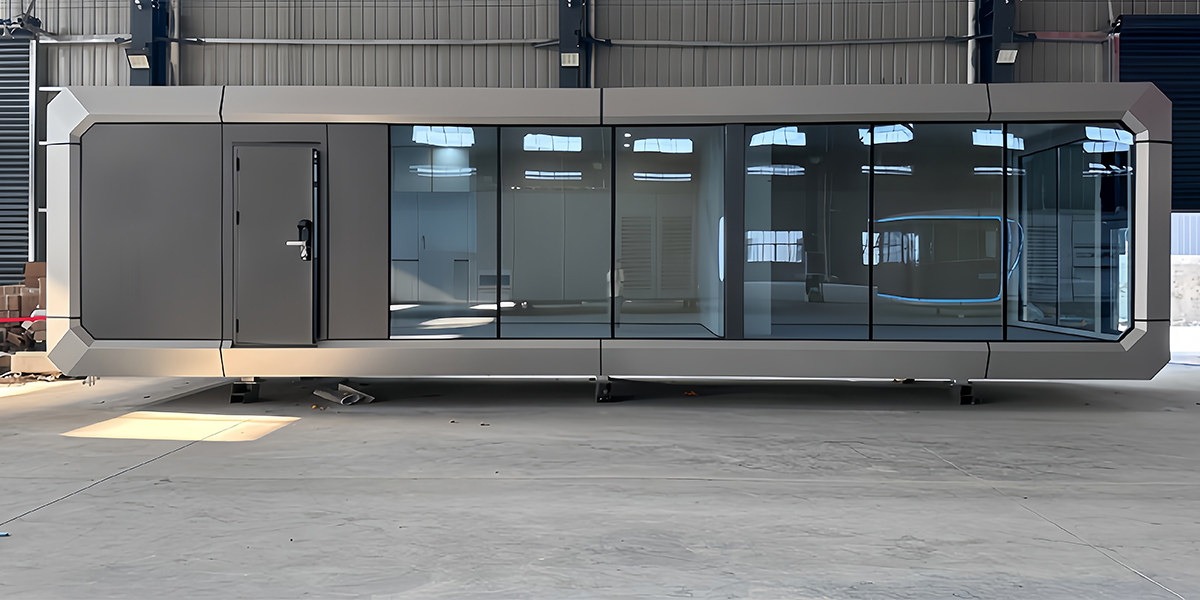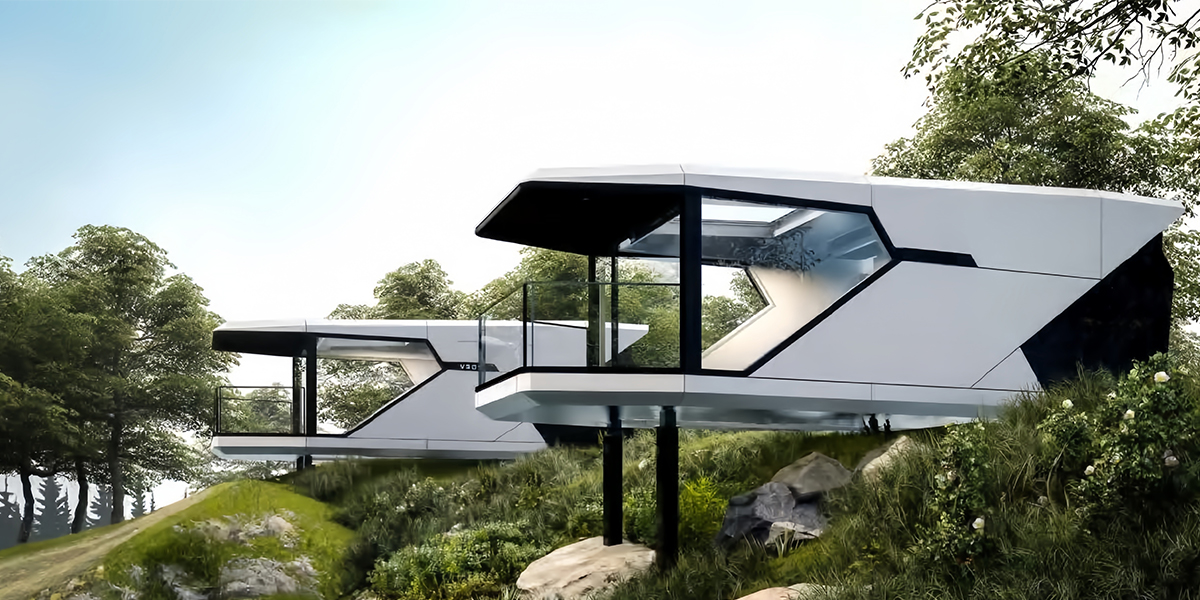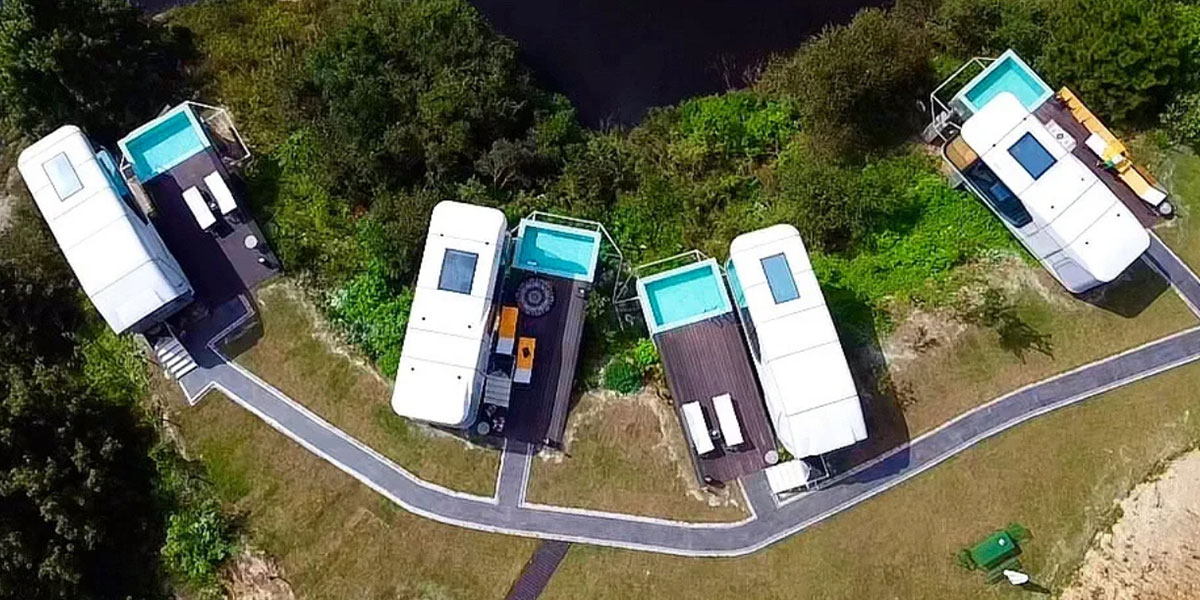
04 Jul What is a Capsule Home The Complete Guide for 2025
Table of Contents
A capsule home gives you all you need in a small space. It is smart and uses space well. You get modern design and smart technology. The materials are good for the environment. People like capsule homes because they save space. Some have solar panels on the roof. Some use recycled materials in the walls. In 2025, more people pick capsule homes. They help the planet by using less energy. They lower energy bills by 15%. Capsule homes are showing up in many cities. The future of living looks good with capsule homes.
Key Takeaways
- Capsule homes use smart and modular designs. They fit everything you need in a small space. This makes them great for city life and small families.
- These homes save energy and money. They use eco-friendly materials and solar panels. Smart technology helps with heating, lighting, and security.
- Modular construction and prefabrication help build homes fast. It is cheaper and lets you expand or change your capsule home easily.
- Capsule homes have furniture that does more than one thing. They also have smart storage to save space. This makes small homes between 200 and 500 square feet feel comfy.
- Living in a capsule home helps you spend less money. You can live in a green way. You also get flexible housing in cities or off-grid places.
Capsule Home Basics
What is a Capsule Home
You may wonder how a capsule home is different. A capsule home is a small unit with all you need. It has a bed and a bathroom. Sometimes, there is a kitchenette too. Everything fits in one small area. The layout is smart and storage is clever. This helps use every bit of space. You can find capsule houses in cities and near schools. Some are even in faraway places. Many have smart technology for lights and temperature. This makes life easier.
Capsule houses are special because of modular designs. You can stack or join them to make bigger spaces. Some people build whole groups of capsule homes. Many use eco-friendly materials and save energy. This is good for the planet and your bills.
Tip: Capsule homes often have big windows or rooftop decks. You can enjoy nice views even in a small space.
Capsule House vs. Capsule Home
You might see both “capsule house” and “capsule home” online. They sound alike but are not the same. A capsule house is a single, tiny pod. You often see capsule houses in hotels or hostels. Each one gives you a private place to sleep. Capsule houses are made for privacy and saving space. They are great for people traveling alone.
A capsule home is more like a tiny house. You can live in a capsule home all the time. It has more things, like a kitchen or living room. Capsule homes use modular systems. You can add more capsules if you need space. Some people use capsule homes as vacation cabins or studios. Others use capsule houses for students or city apartments.
Here’s a quick comparison:
Feature | Capsule House | Capsule Home |
|---|---|---|
Main Use | Short stays, hotels, hostels | Full-time living, tiny homes |
Size | Very compact | Compact but more spacious |
Amenities | Bed, basic storage | Bed, kitchen, bathroom, more |
Flexibility | Fixed layout | Modular, expandable |
Common Users | Solo travelers, students | Singles, couples, families |
Both use smart design, but capsule homes give you more comfort and options.
Evolution of Capsule Homes
Capsule houses have an interesting past. The idea started in Japan in the 1970s. At the 1970 Osaka Expo, designers showed the Takara Beautilion. It used cube-shaped capsules in a steel frame. This led to the Nakagin Capsule Tower in Tokyo, built in 1972. The Nakagin Tower had capsules you could remove or move. This matched the Metabolist movement. They wanted cities to grow and change like living things.
Capsule houses were small and sometimes cost a lot. Not everyone could use them. But stacking and joining capsules became popular. Over time, architects made capsule homes cheaper and more flexible. Fumihiko Maki’s Hillside Terrace in Tokyo showed how to group capsule houses. This made bigger communities. Today, capsule homes use these ideas with smart tech and green materials.
Capsule homes are now more popular. Look at how the market is changing:
Metric/Segment | Data/Value | Notes/Implications |
|---|---|---|
USD 262.9 million | Baseline market size for capsule homes globally | |
Market Size 2025 (Forecast) | USD 284.0 million | Demonstrates growth in compact living solutions for 2025 |
Market Size 2030 (Projection) | USD 432.5 million | Indicates strong long-term growth |
CAGR (2025-2030) | 8.8% | Compound annual growth rate showing steady expansion |
Age Group 18-24 Market Share | 41% (2024) | Largest demographic segment attracted to capsule homes |
Age Group 25-39 CAGR | 9.2% (2025-2030) | Fastest growing age group segment |
Solo Travelers Market Share | 71% | Majority user type preferring capsule hotels |
Group Travelers CAGR | 9.2% (2025-2030) | Growing demand among groups |
Booking Mode Offline (2024) | 60% | Majority booking mode currently, but shifting trends expected |
Booking Mode Online CAGR | 9.2% (2025-2030) | Increasing preference for online bookings |
Regional Market Share Asia Pacific (2024) | 58% | Largest regional market |
Regional Market Share North America (2024) | 10% | Emerging market with growing interest |
Recent Developments | Multiple new hotel launches in 2024-2025 | Expansion of capsule hotel footprint in various regions |
Consumer Behavior | High percentage of short stays and hourly bookings | Reflects demand for compact, efficient living solutions |
Capsule houses and capsule homes use smart layouts and tech to save space. Here are some ways they do this:
- The inside is small but has all you need, like bedrooms, bathrooms, and sometimes kitchens.
- Modular designs let you pick different layouts. Capsule houses can fit singles, couples, or families.
- Many have cool designs inspired by space travel. This makes your stay feel special.
- Smart lights, heating, and cooling help save space and keep you comfy.
- Some capsule homes have big windows or rooftop decks for better views.
- Energy systems and green materials make capsule houses great for the planet.
Capsule homes and capsule houses have changed a lot. Now you get more choices, comfort, and smart features than before.
Design and Construction
 Modular Structure
Modular Structure
When you walk into a capsule home, you see smart use of space. The modular structure is the key. Each capsule connects like blocks. You can stack them or put them next to each other. This helps you make bigger rooms or even whole neighborhoods. Modular designs let you add more capsules if you need more space. You can change your layout without breaking walls.
Here’s why modular construction is special:
Advantage Category | Description |
|---|---|
Sustainability | Uses earth-friendly materials and makes less trash. |
Energy Efficiency | Solar panels and good insulation help save energy. |
Rapid Deployment | You can build a modular capsule home in just weeks. |
Cost-Effectiveness | Adding to your capsule home costs less than normal building. |
Adaptability & Scalability | Modular designs let you change your space as you need. |
Quality Control | Factory-made capsules meet high standards every time. |
Design Flexibility | You can pick styles that match what you like. |
Your home can grow with you. Modular capsule homes work well in cities or far from town.
Materials Used
Capsule homes use strong but light materials. Aluminum alloy and light steel are popular choices. These materials make each capsule easy to move and stack. They also help keep your home warm in winter and cool in summer. Builders add things like polyurethane foam or mineral wool for better energy savings.
- Aluminum alloy and light steel make your capsule strong and light.
- These materials last long and do not rust easily.
- They help your capsule home follow green building rules.
- You get a good mix of price, strength, and comfort.
- Capsule homes built this way can handle city weather and travel.
You can count on your modular capsule home to last and fit your needs.
Prefabrication Process
Prefabrication changes how capsule homes are built. Instead of building at the site, workers make each capsule in a factory. This gives better quality and less waste. When the capsules arrive, workers put them together fast. You can move in sooner than with a regular house.
Prefabrication lets you pick what you want in your home. You can choose smart tech, green systems, or special layouts. Modular designs make it easy to upgrade or add more space later. You save time, money, and worry.
Tip: Prefabrication keeps your capsule home affordable and high-quality. You get a modern home without waiting a long time.
Features of Capsule Houses
Smart Home Systems
Capsule houses often have smart home systems. You can use your phone or voice to control lights and temperature. These systems also help with security. You can set the mood with a tap. Your capsule feels comfortable before you get home. Sensors turn off lights when you leave a room. This saves energy and makes life easier. You get comfort and save effort at the same time.
Tip: Smart home systems can remind you to lock the door. They also help you check your energy use. This keeps your home safe and running well.
Multifunctional Furniture
Capsule houses use every bit of space well. Multifunctional furniture is important in these homes. Most capsule homes are between 200 and 500 square feet. You need furniture that does more than one thing. Here are some ways you save space:
- Sleeper sofas let your living room become a bedroom.
- Folding beds hide in the wall when not in use.
- Collapsible tables fold away after you eat or work.
- Ottomans with storage hold your things and give you a seat.
Capsule homes often have open floor plans and built-in storage. This keeps your space neat and easy to use. Big windows and smart lights make your home feel larger and brighter. You get comfort, style, and smart use of space.
Eco-Friendly Solutions
Capsule houses care about the planet. Builders use recycled materials and energy-saving systems. Solar panels on the roof can power your lights and devices. Good insulation keeps your home warm in winter and cool in summer. Many capsule houses use water-saving fixtures and smart climate controls. You get what you need while using less energy and water. This helps you live green and save money.
Note: Eco-friendly features help the earth. They also make your home cheaper and more efficient.
Benefits and Challenges
 Affordable Capsule Homes
Affordable Capsule Homes
You might ask if a capsule home is in your price range. The answer is yes, because these homes cost less than most others. You can pick a capsule that fits your needs and your budget. Capsule house prices are much lower than regular houses. Look at this table to see how the prices stack up:
Cost Aspect | Details / Range |
|---|---|
Upfront Cost Range | $20,000 to $100,000 depending on size and design |
Small Capsule (up to 200 sq ft) | $20,000–$40,000 |
Medium Capsule (201–400 sq ft) | $40,000–$80,000 |
Large Capsule (401–500 sq ft) | $80,000–$100,000 |
Prefabricated vs Custom | Prefab capsules are cheaper and faster to build |
Financing Options | Loans from 1 to 7 years, quick approvals |
Energy Savings | Utility bills drop by about 30% |
Insurance & Property Taxes | Lower due to smaller size |
Rent Reduction | Capsule homes lower city rent costs |
You get a nice home for less money and can pay over time. Moving in is fast and easy. Many people pick capsule houses because they save money and space.
Space Optimization
Capsule homes make the most of every inch. You get smart storage and beds that fold away. Rooms can change to fit what you need. The smart layout and furniture help the space feel bigger. You can live well in a small area and still have all you need. This makes capsule homes great for cities or small lots.
Sustainability
Capsule homes are good for the planet. Builders use recycled stuff and save energy. Solar panels and good insulation help you use less power. Water-saving fixtures help you waste less water. Your bills go down and you help the earth. Picking a capsule house means you care about saving money and being green.
Tip: Living in a capsule home helps you spend less and protect nature at the same time.
Common Challenges
Capsule homes are great, but there are some problems. Experts say these are the most common:
- Getting the land ready is hard if it is not flat.
- Permits can take longer and need more work.
- Hooking up water and power may need special help.
- Bad weather can slow things down or cause damage.
- You must check that your capsule is safe and strong.
Most problems can be fixed by planning and working with good builders. A capsule home is modern, cheap, and green, but it is good to know what to expect.
Applications and Suitability
Who Should Choose Capsule Houses
You might wonder if a capsule is right for you. Capsule houses work best for people who want a simple, modern life. If you are a student, a young professional, or just starting a family, you will love how a capsule fits your needs. Many urban youth and small families pick capsule homes because they are affordable and quick to set up. You can move in fast and start living your way.
- Singles and young couples enjoy the compact design.
- Small families find the space just right.
- People who care about the planet like the eco-friendly features.
- If you want to change your space, you can add or move capsules.
- You can make the inside look just how you want.
Capsule houses give you a smart way to live in the city. You get comfort, style, and a home that grows with you.
Urban and Off-Grid Uses
Capsule homes shine in busy cities. You see them in places where land is hard to find. The capsule uses every inch, so you do not waste space. You can stack capsules or put them side by side. This helps you and your neighbors live close but still have privacy.
- Capsule homes cost less and build faster than regular houses.
- You can move your capsule if you get a new job or want a change.
- The design lets you live green and save money.
- Capsule communities help more people live in small city spaces.
Do you dream of living off the grid? A capsule can do that too. You can set up a capsule in the woods, by the beach, or on a mountain. Solar panels and smart systems help you live anywhere. You get freedom and comfort in one small package.
Note: Capsule homes help solve city housing problems. They make sustainable urban living possible for more people.
Regulations
Before you buy a capsule, check the rules in your area. Some cities have special laws for capsule houses. You may need a permit to place your capsule on land. Some places have rules about size, height, or where you can put your capsule. Always ask local offices what you need to do.
- Some cities welcome capsule homes and make it easy.
- Other places have strict rules, so you must plan ahead.
- You might need help to connect water and power.
If you follow the rules, you can enjoy your capsule without worry. You get a safe, legal home that fits your life.
You’ve seen how a capsule home packs smart design, eco-friendly features, and modern tech into a small space. Capsule homes give you flexibility, quick setup, and a chance to live green. You can customize your capsule to fit your style or move it where you want. Sure, you might face some space or privacy challenges, but regular care and smart planning help a lot. If you want a fresh start in 2025, explore capsule homes and join the future of sustainable living! 🌱
FAQ
What is the average size of a capsule home?
Most capsule homes range from 200 to 500 square feet. You get a cozy space that fits all your needs. The smart design makes every inch count, so you never feel cramped.
Can you customize a capsule home?
Yes, you can! You pick the layout, colors, and features. Many companies let you add smart tech, eco-friendly systems, or extra storage. Your capsule home can match your style.
How long does it take to set up a capsule home?
You can move in fast. Most capsule homes arrive ready to assemble. Setup usually takes a few days to a couple of weeks. You save time compared to building a regular house.
Are capsule homes safe in bad weather?
Capsule homes use strong materials like steel and aluminum. Builders test them for wind, rain, and snow. You stay safe and dry inside. Just check local rules for extra safety steps.




 Modular Structure
Modular Structure Affordable Capsule Homes
Affordable Capsule Homes